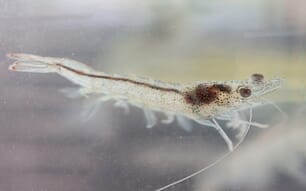Quality is important in the entire process, from the ocean to the dining table, states Kine Mari Karlsen, Project Manager and Senior Scientist.
Now, she and fellow scientists in one of Nofima’s strategic programmes through to 2019, are going to study the catching, slaughtering, processing, technological development, residual raw materials, profitability and marketing in detail.
"We will seek to develop the methods, equipment and expertise needed to understand what it is that affects how quality deteriorates, how it is measured, used and communicated on the journey that the fish takes from being taken out of the ocean alive and through to it being served on your plate. There is already a lot of knowledge about quality, but much of this is piecemeal. We want to put it together in order to view the whole value chain," says Kine Mari Karlsen.
Salmon and mackerel
And since the sea is full of food, it has been necessary to select the products that we are going to study in this research work. The choice fell on salmon and mackerel.
As regards the latter, consumer researcher Themis Altintzoglou is in full swing. He is studying how Japanese consumers perceive Norwegian mackerel. The main objective of the research is to reveal how the quality of Norwegian mackerel is perceived and disseminated by consumers in Japan.
"For Norwegian mackerel, Japan is the biggest market. It seems that the Japanese like Norwegian mackerel. But based on which criteria? Does it matter that the mackerel comes, indeed, from Norway? What bearing does appearance and packaging have? What role does price play? We need to know the answers to these questions if we are to develop exports," says Themis Altintzoglou, also a Senior Scientist at Nofima.
In 2015, Norway exported mackerel worth a total of NOK 3.8 billion. Of this, mackerel worth NOK 715 million went to Japan.
In addition to obtaining knowledge about consumers’ perceptions, the study will also reveal and explain any deviations in how quality is perceived between consumers and other players in the value chain, such as fishermen, manufacturers and exporters.

Senior Scientist Themis Altintzoglou is studying how Japanese consumers perceive Norwegian mackerel. Photo: Audun Iversen ©Nofima
"There are some interesting results," says Themis Altintzoglou, providing us with an example, as a taster:
"Japanese consumers consider the quality of mackerel products on the basis of freshness and product characteristics, while packaging and design are not so important to them. In practice, this means that they consider what is in the package much more than what is on the package. We can also conclude that Japanese consumers trust their retailers and use them as their main source of information on fish quality."
Seafood products of high quality
The study of mackerel is also part of a larger on-going project, where Nofima wants to view the big picture when it comes to what affects seafood quality. The object of the research project is to help provide consumers with high quality seafood Products.
That brings us back to the question of what quality actually is. Project Manager Kine Mari Karlsen says that it is not an easy question to answer, because it depends on who assesses the quality of the fish and what is emphasised.
"There is no universal definition. Quality is often understood from the context. In this project, we are looking at these perspectives:
- Product-based quality: Quality is defined by precise and measurable factors such as fat content.
- Production-based quality: Quality is linked to the products being manufactured in accordance with requirements or specifications.
- Customer-based quality: Quality is defined by the customers’ different desires and needs, and the items that best meets their preferences are those that they consider the highest quality.
- Value-based quality: Quality is defined by the cost and price. A quality product must have an acceptable price and/or cost.
The strategic project, named “Seafood Quality”, was started in March 2015 and will go on until the end of February 2019.




